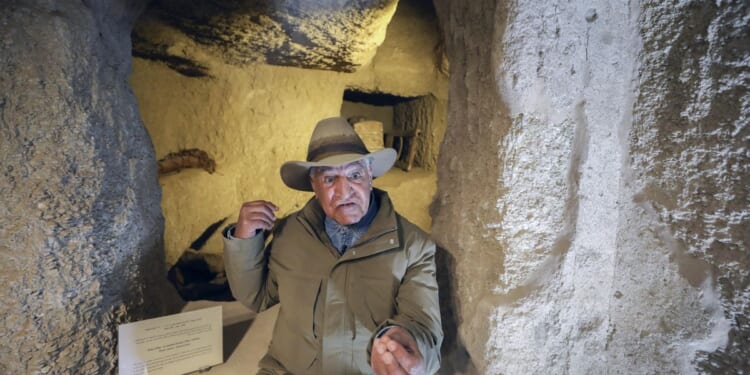
A research team’s astonishing claims that they discovered massive underground structures extending hundreds of feet deep beneath Egypt’s Khafre Pyramid sound like science fiction to experts.
Scottish and Italian researchers say they used special radar technology that allowed them to see far beneath the 4,500-year-old pyramid.
They said the technology revealed five structures connected by miles of geometric pathways and eight spiral staircases descending thousands of feet underground.
At the very bottom, the radar detected two square structures each measuring 67,000 square feet and spanning beyond Khafre to all three pyramids of the Giza Plateau.
Their announcement, livestreamed from Italy on March 15, sent shockwaves through the world of Egyptology and their findings at first glance appeared to be one of the most significant archaeological discoveries in modern times.
Research team spokeswoman Nicole Ciccolo teased the announcement as the “discovery of a huge city under the pyramids.”
The jaw-dropping claims, however, may be at best an exaggeration and at worst a complete fabrication, critics in the field say.
Egypt’s renowned archaeologist and former minister of antiquities trashed the findings, calling them “fake news.”
Zahi Hawass said the researchers used techniques that are “not approved” and “not validated” and lack any scientific basis.
The Khafre Pyramid, Mr. Hawass said, was studied extensively and it was determined the massive structure was carved directly from the bedrock. “All claims regarding the existence of columns beneath it are entirely unfounded,” he said.
The Washington Times sought a response from the researchers, Corrado Malanga of the University of Pisa in Italy and Filippo Biondi of the University of Strathclyde in Scotland. They have not yet responded.
Mr. Malanga and Mr. Biondi first published a report on using Synthetic Aperture Radar technology to view beneath the Giza Plateau in August 2022.
They asked University of Denver Professor Lawrence B. Conyers, a leading expert on ground-penetrating radar, to peer-review the article.
Mr. Conyers told The Washington Times that their methodology was promising, but their conclusions were a mystery to him because they appeared to be based on pages of highly complicated math formulas that required much more analysis than he could provide.
“Methods and their interpretation of the data that they acquired using those methods are two separate things,” he said.
Mr. Conyers said he was skeptical of their claims that their radar could penetrate thousands of feet. He said he’s only been able to penetrate about 30 feet in his extensive experience with the equipment because radar waves attenuate, or get pulled away, while underground.
“I don’t care what kind of radar you are using, whether you are using synthetic aperture radar or Doppler shift radar. The fact of the matter is … there is going to be a limit to how deeply we can get these to penetrate,” Mr. Conyers said.
The researchers have not published their latest claims in a scientific journal or had them peer-reviewed.
Mr. Malanga and Mr. Biondi said they built a three-dimensional model of the pyramid underworld utilizing data from radar mounted on satellites orbiting around the Earth.
Egypt tightly controls research at the pyramid sites and Mr. Hawass said the scientists making the claims about Khafre never conducted research at the site.
The researchers said it wasn’t necessary to be at the pyramid.
The radar could penetrate the limestone and granite pyramids from afar by converting light into sound.
“If we manage to transform light into sound, what will appear is that granite is more transparent than glass,” Mr. Malanga said, according to a translation of the press conference.
Mr. Malanga said the radar revealed strange findings under the pyramid, such as a “world” with “luminous stuff that vibrates.” The large columns appeared to be needed to stabilize the pyramid above it, he said, but also may have served other mysterious purposes involving the electromagnetic field.
Egypt’s pyramid experts scoffed at the findings.
Mr. Hawass accused the group of making outlandish claims “to undermine the grandeur of ancient Egyptian civilization.”
Mr. Conway said he does not dismiss the findings entirely. Many other pyramids, including the largest one in North America, are built upon underground structures, he said. Ancient civilizations built caves and tunnels to bury the dead and to hold religious or ritualistic ceremonies.
Tunnels and structures beneath ancient pyramids, he said, “are entirely plausible,” but claims that satellite radar shows the details of a vast city beneath Egypt’s Giza Plateau aren’t as believable.
“Put me down as a scientific skeptic,” he said.








